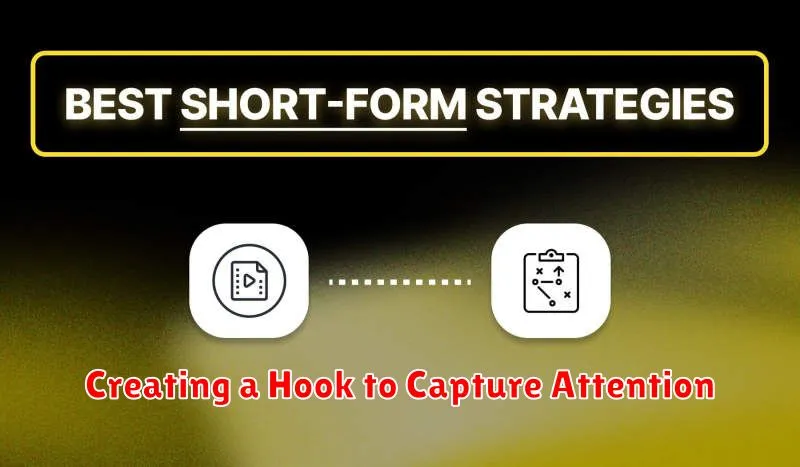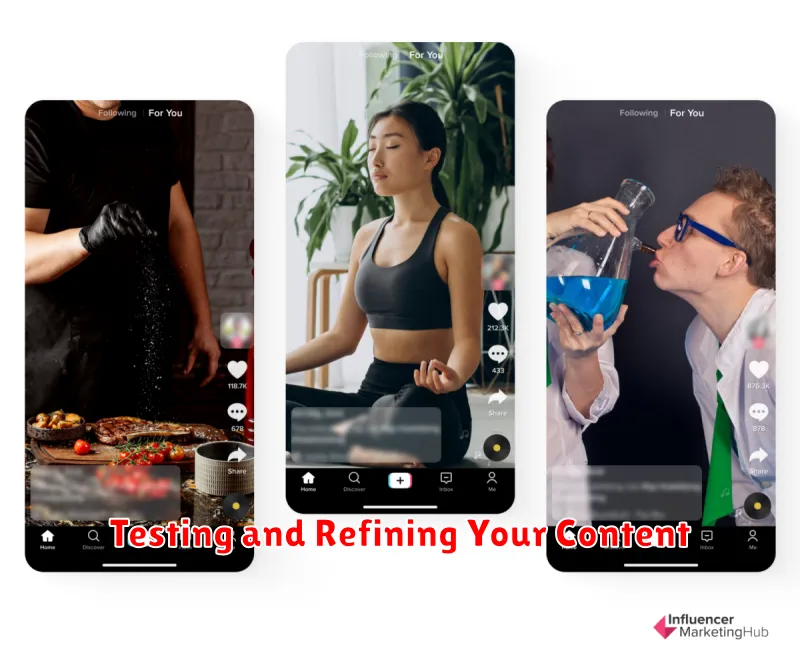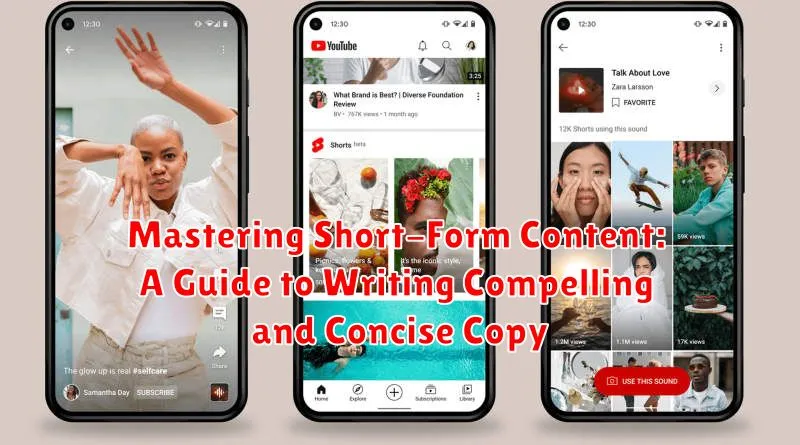In today’s fast-paced digital world, capturing attention quickly is paramount. Short-form content has emerged as a dominant force, shaping how we communicate and consume information. This comprehensive guide provides a deep dive into mastering short-form content, offering practical strategies for writing compelling and concise copy that resonates with your target audience. Whether you’re crafting social media posts, email subject lines, or website snippets, understanding the nuances of short-form writing is essential for success.
From tweets to captions, short-form content demands precision and impact. Learn how to distill your message to its core essence, maximizing every word for optimal engagement. This guide will equip you with the techniques needed to create compelling and concise copy that grabs attention, sparks interest, and ultimately drives action. Explore the power of brevity and discover how to make every character count in the realm of short-form content.
Understanding the Power of Short-Form Content
In today’s fast-paced digital world, grabbing and holding attention is more challenging than ever. This is where the power of short-form content shines. It caters to our shrinking attention spans and desire for easily digestible information.
Short-form content offers a quick, impactful way to connect with your audience. Think about it: social media posts, headlines, email subject lines, and even text messages all fall under this umbrella. These snippets of information are often the first point of contact a potential customer has with your brand. First impressions matter, and short-form content allows you to make a strong one.
By delivering concise and compelling messaging, you can quickly convey key information, generate interest, and ultimately drive action. It’s about maximizing impact with minimal words.
Defining Your Target Audience and Their Needs
Before crafting any short-form content, it’s crucial to define your target audience. Understanding their needs, preferences, and pain points will guide your writing and ensure your message resonates effectively. This involves more than just basic demographics.
Consider their:
- Knowledge level about the subject matter
- Motivations and what drives their actions
- Preferred communication style (formal, informal, humorous, etc.)
- Platforms where they consume content
Creating detailed buyer personas can be helpful. These semi-fictional representations of your ideal customer provide a tangible image of who you’re writing for. By clearly defining your audience, you can tailor your short-form content to address their specific needs and achieve your communication goals.
Crafting a Clear and Concise Message
Conciseness is paramount in short-form content. Every word must contribute to the overall message. Avoid jargon and overly complex language. Clarity is key; your audience should immediately grasp the meaning without rereading.
Begin by identifying the core message you want to convey. What is the single most important takeaway for your readers? Once established, build your content around this central idea, eliminating anything extraneous.
Structure your content logically. Use short sentences and paragraphs. Bullet points or numbered lists can enhance readability and break down complex information into easily digestible chunks.
Regularly review and edit your work. Look for opportunities to tighten phrasing and remove redundant words. Reading your content aloud can help identify areas that lack clarity or flow.
Using Strong Verbs and Active Voice
Strong verbs inject energy and precision into your short-form content. They paint vivid pictures and make your writing more dynamic. Instead of saying “The company made an announcement,” try “The company announced.” The second example is more direct and impactful.
Active voice further enhances clarity and conciseness. It clearly defines who is performing the action. Active voice follows the subject-verb-object structure. For example, “The chef prepared the meal” (active) is stronger and more direct than “The meal was prepared by the chef” (passive).
Consider these examples:
| Weak Verb/Passive Voice | Strong Verb/Active Voice |
|---|---|
| The report was written by the team. | The team wrote the report. |
| A decision was made to implement the new policy. | The board implemented the new policy. |
By using strong verbs and active voice, you create content that is more engaging and easier to understand, vital components of effective short-form writing.
Creating a Hook to Capture Attention

In the realm of short-form content, capturing attention within the first few seconds is crucial. A compelling hook acts as a magnet, drawing readers in and encouraging them to delve deeper into your message. Without a strong hook, your content risks being lost in the constant stream of information.
Several effective techniques can be employed to create a captivating hook. Start with a provocative question that challenges readers’ assumptions or piques their curiosity. Alternatively, present a surprising statistic or fact that immediately grabs their attention. A bold statement can also be highly effective, especially if it’s slightly controversial or unexpected.
Anecdotes offer a relatable entry point, allowing readers to connect with the content on a personal level. Similarly, beginning with a vivid description can paint a picture in readers’ minds, instantly immersing them in the topic. The key is to select a hook that aligns with your overall message and target audience.
Incorporating Visuals and Multimedia Elements
While short-form content emphasizes brevity, visuals and multimedia can significantly enhance its impact. Visual elements like photos, illustrations, and infographics can quickly convey complex information and add visual interest. Consider using them to break up text and make your content more engaging.
Multimedia, such as short videos and audio clips, can further enrich the user experience. A brief video demonstrating a product or an audio clip highlighting a key message can add depth and memorability to your content. Choosing the right visuals and multimedia is crucial. They should complement your written message and not distract from it.
Remember to keep file sizes small for optimal loading speeds, particularly on mobile devices. Ensure your visual and multimedia elements are accessible to all users, including those with disabilities. Provide alt text for images and captions for videos to improve accessibility and provide context.
Optimizing for Readability and Scannability
In the realm of short-form content, readability and scannability are paramount. Readers often skim through content quickly, so ensuring your message is easily digestible is crucial.
Short sentences and concise paragraphs significantly enhance readability. Aim for a sentence length of around 20-25 words and keep paragraphs to a maximum of three to four sentences. This allows readers to absorb information quickly and effortlessly.
Bullet points and numbered lists break up large blocks of text and highlight key takeaways. They offer a visually appealing way to present information in a structured and easily scannable format.
Utilizing bold text and headings helps draw attention to important points. These formatting choices guide the reader’s eye and emphasize key elements of your content.
White space is equally important. Ample spacing between lines and paragraphs prevents your content from appearing cluttered and overwhelming, contributing to a more pleasant reading experience.
Adding a Call to Action
A compelling call to action (CTA) is crucial for short-form content. It directs your audience towards the desired next step, whether it’s visiting a website, making a purchase, or sharing the content. Without a clear CTA, your message loses its impact and potential for conversion.
Effective CTAs are concise and action-oriented. Use strong verbs that encourage immediate action. For example, instead of “Learn More,” consider using “Discover More Now” or “Get Started Today.” The sense of urgency can significantly improve engagement.
Tailor your CTA to your specific audience and platform. A CTA for a social media post will likely differ from one on a website banner. Consider what action is most appropriate for the context and what language will resonate most effectively with your target demographic.
Ensure your CTA is easily visible and accessible. Use visual cues like buttons or contrasting colors to make it stand out. In short-form content, where attention spans are limited, a prominent CTA is essential for maximizing its effectiveness.
Testing and Refining Your Short-Form Content

Even the most meticulously crafted short-form content can benefit from testing and refinement. A/B testing is a powerful technique for comparing different versions of your content. Create variations by altering headlines, calls to action, or even the order of information presented. Track key metrics like click-through rates, conversion rates, and engagement metrics to determine which version performs best.
Gather feedback from a small group representative of your target audience. Ask them for their honest opinions on the clarity, conciseness, and impact of your content. Are they compelled by the hook? Do they understand the message? Does the call to action resonate with them? Use their feedback to make informed revisions.
Analyze performance data once your content is live. Monitor metrics and identify areas for improvement. If a piece of content isn’t performing as expected, revisit the content creation process. Consider adjustments to headlines, calls to action, visuals, or overall messaging based on the data collected. Continuously refining your content based on performance data is crucial for maximizing its effectiveness.

